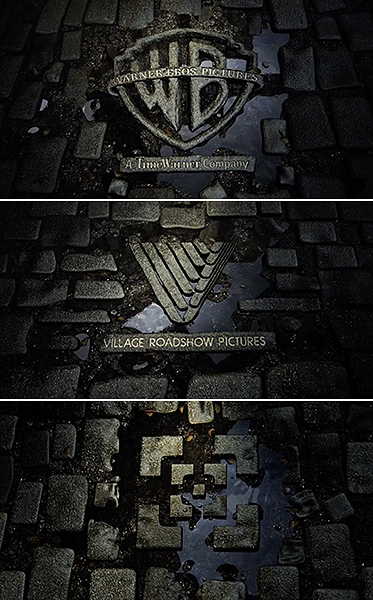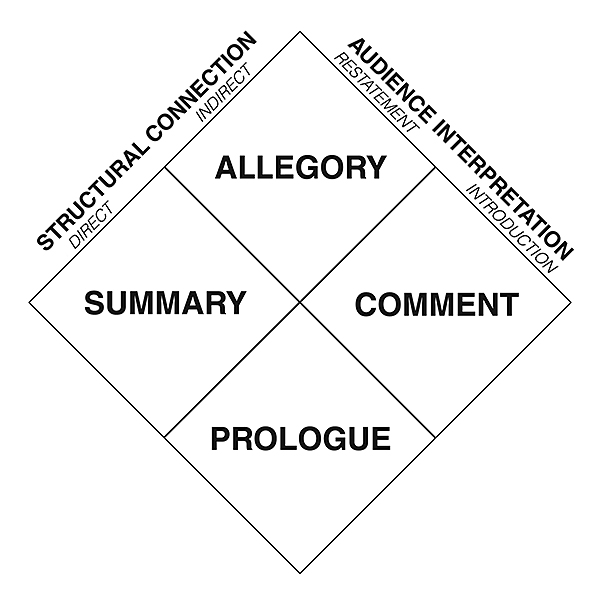|
This is an excerpt from my book Title Sequences as Paratexts published by Routledge.
Hollywood has viewed the credits or title sequence as a �distraction� for decades, an interruption interfering with the dramatic realism of the motion picture. This conception can be seen in the ideological �force� of realism that promotes the elimination (or minimization) of the title sequence to start the fabula immediately. However, the �invisibility� of titles has been an ideal for commercial cinema since the Silent Period, as the film historian and documentary theorist Paul Rotha observed in 1930: �a well-titled film is one in which the titles harmonize with the visual images so perfectly that their presence as titles is not remarked.� The crediting function for openings cannot be avoided. Since the title sequence conventionally signifies the start/conclusion of the narrative, the role of narrative in title sequences is always already a given, unavoidable because narratives must begin and end. The conception of text on-screen as a abstraction, stylized, explains the elided title sequence in motion pictures such as Sherlock Holmes (2009) that leaves only the required credits which start the story, the production company logos, but embeds them within the diegetic space on screen; an elaborate main-on-end designed by Danny Yount comes at the conclusion, providing a dramatic ending beyond what appears in the narrative. It is a formal construction guided by the ideological concerns of realism. The attempt to �disappear� the credits into the narrative demonstrates a desire to produce motion pictures comparable to reality, able to displace lived experience and in the process make its idealized fantasy real.

Danny Yount, studio logo graphics from the opening to Sherlock Holmes (2009)
How the audience understands the distinction between the credits and its role for narrative when watching any title sequence is not an either/or opposition. The propositional conflict between peritext::text makes the degree of realism the critical focus, conceiving of the audience as passive, easily manipulated, uncritically accepting and embracing whatever they encounter in the motion picture, the ideological and political aspects of traditional viewership makes the manipulated complicit with their own manipulation, but powerless to challenge it, and possibly even unwilling to consider it is happening. It reifies this historical assumption that audiences are not sophisticated readers consciously choosing their critical or uncritical engagements with the text. Such a passive conception of viewership is incorrect. The audience interprets these designs as part of a state of information where meaning develops from the lower-level d�coupage. These articulations form the title sequence as a particular enunciation in the motion picture as a whole. The range of naturalism::stylization is another lower-level marker for these same issues of narrative function. How closely integrated peritext::text are determines whether the audience will interpret the title sequence as a distinct section, as a introduction flowing into the narrative, or as entirely absent. The relationships between these sequences identify the ideological dimensions of realism::stylization as an interpretive constraint.

Audience engagement and structural organization interact to link enunciation and ideology via narrative semiosis in the title sequence. The statement posed by the credit sequence cannot be disregarded as anterior or extraneous to the elaboration of fabula. The Allegory, Comment, Summary and Prologue modes are created by the necessary and sufficient conditions of [1] the structural connection between the title sequence and the narrative (an opposition of direct::indirect linkages) and [2] how the audience interpretation of the fabula as suggested in the title sequence (as the opposed pair introduction::restatement). Titles are the literal beginning or ending of the film narration, as the scrolling credits at the conclusion of The Holy Mountain demonstrate by negating the Brechtian rupture posed by Jodorowsky�s final fade to white. The titles assertion that the �film is only a film� is ideological. It negates this Brechtian rupture that violates the realist (bourgeois) ideology assumes the passivity of its audiences, demanding �entertainment� whose contents and meanings are safely contained, and once separated, remain distant from life.
The intratextual connection between title sequence (peritext) and main text reveals how the semiotic engagements of �innocent� and �sophisticated� viewers produces these distinct units of exposition; the simple and complex variants of these four modes correspond to different potential interpretations of narrative function. The simple forms of each mode tend towards an immediate recognition, and develop from an unproblematic morphology and structure: the associated narrative elements are readily apparent, requiring a minimum of prior knowledge to identify them within the title sequence. The simple variants, due to their explicit construction, appear so immediately comprehensible and their connections to the narrative are so obvious they do not appear to require theorization or analysis. The complex modes, in contrast, develop explicitly from �sophisticated� audiences using their established, specialized knowledge about the narrative to recognize those events in the title sequence. This use of external recognitions�whether intertextual, or simply intratextual is irrelevant since they are outside the pseudo-independent sequence�draws attention to the incompleteness of enunciation and the determinate role that audience engagement has in all narrative semiosis.
The indirect modes of association both share an ambivalence in relation to the narrative that makes the �sophisticated� engagement central to their elaboration as fabula: the Allegory mode specifically depends on audience recognition of an excess to their symbolic presentation that links the title sequence with the narrative; the Comment mode requires the audience to already know the story for its statements about the fabula become coherent. These indirect interpretations transform ideological considerations into symbolic form. Comment mode designs act as an indirect introduction, without the ambivalence common to allegorical constructions. �Symbolic� meanings reveal the fractal repetition between low-level identifications of symbolic meaning (the rebus title card), the mid-level pseudo-independence of the title sequence, and the higher-level connection of title sequence to narrative productive of fabula. These expositions emerge from the combination of rebus mode title cards and synchronization to articulate the additional, hidden signification that defines their indirect connections to narrative. Only a conscious decision by the audience, prompted by the recognitions of rebus mode title cards, can transform either Allegory or Comment mode designs into an immanent engagement with the fabula. Distinguishing the Comment mode from the Allegory mode is more than a difference in emphasis and organization: it makes a statement about the narrative without specifically identifying what those contents are.
The narrative function dominates the direct modes, mediated by the viewer�s understanding the title sequence as a restatement of the story, or as its beginning�whether the title sequence is a self-contained, pseudo-independent unit, or integrated with/into the progression of syuzhet. The dynamic between realism::stylization is a literal constraint on these designs, making their ideological content into their material form. Summary mode encapsulates the narrative as a cause-effect sequence that cannot be interpreted as �backstory.� Audience understanding of the Summary mode is determined by title placement, typically either beginning or ending the motion picture. This location-dependence does not introduce the fabula. It creates a superficial misconception of these designs as �spoilers� (anticipation) or �nostalgia� (recapitulation). In contrast, Prologue expositions are integrated into the narrative immediately, typically as specifically openers, as the (literal) beginning of the fabula; when placed at the conclusion, Prologue modes are understood as �epilogues.� Their narrative function makes the ideological heritage of nineteenth century melodrama, the attempt to realize a total illusion, readily apparent in their design.
Connective interpretations act to elide the narrative distinctions between peritext::text, unifying the production. Both direct and indirect expositions describe a range for narrative function in title sequences. The elaboration and development of fabula within the title sequence is a commonplace element of commercial media production. Realism::stylization apparent as the crediting function enables a formal distinction from the rest of the motion picture that masks its ideological content; the dominance of narrative function is also a dominance of syuzhet, apparent from the essential narrative information the titles provide. The historical development of the Prologue mode makes the ideological dimensions of realism::stylization apparent in the demand for an immediate connection to the fabula, an easing into or out of the story. This role for titles as a component of the naturalism shown on-screen has been the foundational concern of such designs in Hollywood films since the distinct roles for intertitles and text-on-screen emerged in the 1910s from the earlier �cinema of attractions.� The distinction between the title sequence and the other sequences within the narrative demonstrates the enduring power of these realist aesthetics for commercial motion pictures.
The implicit demand that audience engagement unquestionably accept the contents of realist depictions is neither simple nor readily explained by the passive::active opposition that gives criticism a privileged position. Conflicts over and between credits and story�historically apparent in the limitations on narrative function�reveal the assumed-challenge of the title sequence as interrupting the illusion of life projected on-screen. Those designs where the title sequence is minimized at the start and maximized as a spectacle at the conclusion (redressing any missteps in the narrative final�) are assertions of a specifically realist ideology that affirms its established order through the narrative events of the fictive world on screen.
Titles establish �unity� by asserting established lexical codes as the only appropriate and correct way to interpret the motion picture. Thus this ideological critique ultimately becomes familiar: the ways realist ideology develops in the title sequence reflects the same development of ideology in the realism generally. The novelty of this analysis lies with the distinctions arising from how ideology organizes its material support in the peritext::text dynamic. Realism is an ideological constraint informing the design of titles, governing their placement, significance, and role in the narrative itself. It is offers narrative intelligibility as a pure enclosing of �life� as a series of unalterable formulas that obscure their arbitrary nature with the appearance of necessity. They cannot be another way. In revealing a world, cinematic realism attempts to make depiction into fact.
|

|